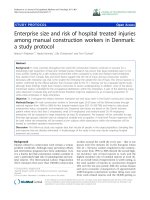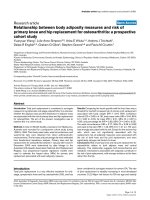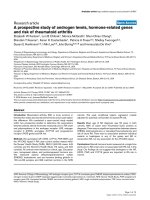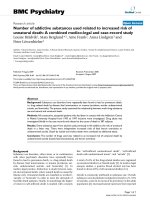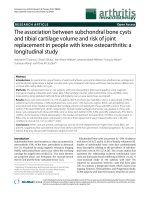Lipid profile and risk of ovarian tumours: A meta-analysis
Bạn đang xem bản rút gọn của tài liệu. Xem và tải ngay bản đầy đủ của tài liệu tại đây (1.66 MB, 8 trang )
Onwuka et al. BMC Cancer
(2020) 20:200
/>
RESEARCH ARTICLE
Open Access
Lipid profile and risk of ovarian tumours: a
meta-analysis
Justina Ucheojor Onwuka1 , Akinkunmi Paul Okekunle2,3,4*† , Olaniyi Matthew Olutola3 ,
Onoja Matthew Akpa3,5† and Rennan Feng2*†
Abstract
Background: Existing data from several reports on the association between lipid profile and ovarian tumour (OT)
suggests divergent conclusions. Our aim was to examine whether circulating lipid profile: total cholesterol (TC),
triglyceride (TG), high-density lipoprotein (HDL) and low-density lipoprotein (LDL) differed between cases and noncases of OT.
Methods: Electronic repositories; PUBMED, EMBASE and Cochrane library were explored through December 2019
to retrieve published articles for inclusion in the meta-analysis after quality assessment. Heterogeneity was assessed
using I2 statistics, the effect of individual studies on the overall effect size was tested using sensitivity analysis and
funnel plot was used to evaluate publication bias.
Results: Twelve studies, involving 1767 OT cases and 229,167 non-cases of OT were included in this meta-analysis
and I2 statistics ranged between 97 and 99%. Mean circulating TC (− 16.60 [− 32.43, − 0.77]mg/dL; P = 0.04) and HDL
(− 0.25[− 0.43, − 0.08]mmol/L; P = 0.005) were significantly lower among OT cases compared to non-OT cases.
Conclusion: Decreased TC and HDL profiles were observed among subjects with OT in this collection of reports.
The implications of TC and HDL in tumour manifestations and growth need to be validated in a large multi-ethnic
longitudinal cohort adjusting for relevant confounders.
Keywords: Lipid profile, Total cholesterol, Triglyceride, High-density lipoprotein, Low-density lipo-protein, Ovarian
tumour
Introduction
Ovarian cancer is the most deadly gynaecological malignancy among women, comprising diverse groups of neoplasm [1]. It accounts for 2.3% of all cancer-related
death in the US [2], 4% of all new cancer cases among
women, the fifth commonest cancer and the fourth
cause of malignancy-related death in the UK [3]. Lipids
are biologically-important hydrophobic molecules vital
* Correspondence: ;
†
Akinkunmi Paul Okekunle, Onoja Matthew Akpa and Rennan Feng
contributed equally to this work.
2
Department of Nutrition and Food Hygiene, College of Public Health,
Harbin Medical University, 157 Baojian Street, Harbin, Heilongjiang 150081,
People’s Republic of China
Full list of author information is available at the end of the article
for energy storage, cell signalling, maintenance of cell
membrane integrity [4] and are transported in the
bloodstream with the aid of lipoprotein [5].
Several studies have reported the relationship between
lipid profiles; total cholesterol (TC), triglycerides (TG),
high-density lipoprotein cholesterol (HDL) and lowdensity lipoprotein cholesterol (LDL) and ovarian
tumour (OT) with different conclusions. For example,
Camuzcuoglu et al. [6] and Bukhari et al. [7] in separate
reports observed TC was significantly lower among OT
patients compared to healthy controls. Contrariwise,
Melvin et al. [8] observed no difference in circulating
TC profiles between cases and non-cases of OT. Furthermore, Gadomska et al. [9] and Camuzcuoglu et al.
© The Author(s). 2020 Open Access This article is licensed under a Creative Commons Attribution 4.0 International License,
which permits use, sharing, adaptation, distribution and reproduction in any medium or format, as long as you give
appropriate credit to the original author(s) and the source, provide a link to the Creative Commons licence, and indicate if
changes were made. The images or other third party material in this article are included in the article's Creative Commons
licence, unless indicated otherwise in a credit line to the material. If material is not included in the article's Creative Commons
licence and your intended use is not permitted by statutory regulation or exceeds the permitted use, you will need to obtain
permission directly from the copyright holder. To view a copy of this licence, visit />The Creative Commons Public Domain Dedication waiver ( applies to the
data made available in this article, unless otherwise stated in a credit line to the data.
Onwuka et al. BMC Cancer
(2020) 20:200
[6] found HDL profile was lower among OT patients
compared to healthy controls. Whereas, Delimaris et al.
[10] and Melvin et al. [8] found no association between
HDL and OT risk.
Drawing vivid inferences from prior population-based
studies on lipid profile and OT risk appears difficult because of disparities in participants’ selections, study designs, etc. In addition, scientific evidence on this subject
is of great significance to clarify whether alterations in
circulating lipid profiles are sufficient to promote OT
risk or these alterations are only a reflection of previously compromised health status.
To this effect, a comprehensive analysis, comprising
previous studies across diverse population would be necessary. Therefore, this study investigated the true difference in circulating lipid profiles (TC, TG, HDL and
LDL) among subjects with and without OT using a
meta-analytical approach.
Materials and methods
This meta-analysis was prospectively registered on
PROSPERO ( />display_record.php?ID=CRD42018099728) and conducted using the MOOSE guidelines [11, 12]. Electronic scientific repositories; PubMed, EMBASE and
Cochrane Library were extensively searched (without
language and period of publication restrictions)
through December 2019 to identify published studies
using the following keywords: “lipid profile” OR “total
cholesterol” OR “triglycerides” OR “high-density lipoprotein” OR “low-density lipoprotein” AND “ovarian
cancer” OR “ovarian carcinoma” OR “epithelial ovarian cancer” OR “ epithelial ovarian carcinoma” OR
“ovarian benign tumour” OR “ovarian malignant
tumour” OR “ovarian tumour”. Also, references of retrieved articles were searched manually for more
studies and PRISMA flowchart explaining the search
methodology is shown in Fig. 1. In addition, evaluation of titles and abstracts of retrieved articles were
independently done by two reviewers and difference(s)
were addressed in consultation with a third reviewer.
Study selection
A study is included in the meta-analysis if it; (a) is a casecontrol studies in human population that investigated the
association between lipid profiles and ovarian tumour, (b)
compared cases (women with ovarian tumour) with noncases (women without ovarian tumour) and (c) reported
lipid profile (TC and/or HDL and/or LDL and/or TG) in
bloodstream in at least two groups (cases and non-cases)
for comparison in a singular study. Similar reports among
pregnant and lactating women, animals and cell lines were
excluded. Also, abstracts, reviews, letter to the editor and
conference papers were excluded.
Page 2 of 8
Quality assessment of studies
The methodological quality and risk of bias of studies included in the meta-analysis were assessed using the
Cochrane Collaboration guidelines and the NewcastleOttawa scale [13]. Briefly, two reviewers independently
appraised the quality of studies and dissimilarities were
conciliated by a third reviewer.
Data extraction
Name of authors, year of publication, country, study
population, sample size, lipid profile(s) determined,
methods of analysis, criteria for case definition, mean
values [with standard deviation (SD), standard error of
mean (SEM), confidence interval (CI)] of serum lipid
profile (TC, HDL, LDL and TG) were extracted independently by two reviewers and differences in data extractions were resolved in recourse to a third reviewer.
To ensure uniformity of estimates, mean values of TC
were transformed to (mg/dL), but TG, HDL and LDL
were transformed to (mmol/L). Also, all values reported
as SEM and CI were transformed into SD [14].
Statistical analysis
Heterogeneity of pooled effect estimate and the magnitude of variation across studies was assessed using I2 test
statistics. A random-effects model was used to obtain
mean estimates under considerable heterogeneity (i.e I2test > 50% or P < 0.05), but a fixed-effect model was applied to obtain mean estimates when I2-test < 50% or
P > 0.05. The random effect model postulates mean estimates of lipid profile(s) differed across studies, but follow a distribution and pooled mean is estimated as the
average mean difference with an assumption that differences in mean estimates are symmetrically distributed.
However, the fixed effect estimates assumed that observed differences are primarily an after-effect of chance
[12, 15].
Statistical analysis was conducted using Review Manager 5.3 and two-tailed P < 0.05 was considered statistically significant. Sensitivity analysis of pooled mean
estimates was assessed using a leave-one-out method
and publication bias was assessed using a funnel plot.
Results
Literature search
Of the 1619 records obtained from the primary literature search, 377 duplicates and 1079 records were excluded after examining titles and abstracts. Also, 151
records were excluded after full-text evaluation and 12
studies [6–10, 16–22] comprising 1767 OT cases and
229,167 non-cases of OT met the inclusion criteria
(Fig. 1). Characteristics of the included studies are
shown in Table 1.
Onwuka et al. BMC Cancer
(2020) 20:200
Page 3 of 8
Fig. 1 PRISMA flowchart for inclusion and exclusion of studies in the meta – analyses
Pooled mean difference of circulating TC, TG, LDL, HDL
between OT and non-OT subjects
Mean TC; − 16.60 [− 32.43, − 0.77]mg/dL, P = 0.04 was
significantly lower among OT cases compared to nonOT subjects (Table 2 and Fig. 2). Similarly, mean HDL;
− 0.25 [− 0.43, − 0.08]mmol/L, P = 0.005 was significantly
lower among OT cases compared to non-OT subjects.
However, these differences were insignificant after stratifying by age groups. Also, mean TG and LDL differed
insignificantly between OT and non-OT subjects.
Stratifying our meta-analysis by age (Table 2), TG profile
was significantly elevated; 0.61 [0.57, 0.65]mmol/L P <
0.0001 among OT subjects < 49 years only. Contrariwise,
LDL profile was significantly elevated; 0.37 [0.24,
0.50]mmol/L P < 0.0001 among OT subjects > 49 years only.
TC was significantly lower (− 31.55 [− 62.72, − 0.37] mg/dL
P < 0.05) among OT subjects with malignant and/or advanced tumours. TC and LDL profiles were insignificantly
different, but HDL profile was significantly lower between
OT and non-OT subjects in studies with low risk of bias.
Onwuka et al. BMC Cancer
(2020) 20:200
Page 4 of 8
Table 1 Characteristics of all eligible studies for lipid profile and risk of ovarian tumours
Ascertainment of ovarian tumour cases
Classificationf Accountability
of bias
TC, TG,
HDL, LDLb
Hospital/Medical record confirmed using color flow
Doppler tests, biopsies and MRI
NR
NR
29e
TC, TG,
HDL, LDLb
Hospital/Medical record
FIGO
Excludedg, h
573
1146d
TG, HDLb
Hospital confirmed
FIGO
Excludedh,i
28
66e
TCb
Histopathological examinations
NR
NR
Delimaris et al. 2007 Greece
[10]
15
d
30
TC, HDL,
LDLb
Hospital/Medical records,
TNM
Excludedg
Gadomska
et al. [18]
1997 NR
25
25e
TC, TG,
HDLb
Histopathological examinations
FIGO
NR
Gadomska
et al. [9]
2005 Poland
91
44 e
TC, TG,
HDLb
Histopathological examinations, Transvaginal
ultrasonography,
FIGO
NR
Knapp et al.
[19]
2017 Poland
74
81e
TC, TG
Transvaginal sonography evaluation, Histopathological FIGO
examinations, CT scan
Excludedh,i
Kuesel et al.
[20, 23]
1992 Canada 62
51e
TC, TG
NR
FIGO
NR
Melvin et al [8] 2012 Sweden 786
227,
603d
TC, TG,
HDL, LDLb
Verifiable database
NR
NR
Qadir et al.
[21]
2008 Pakistan 40
50d
TC, TG,
HDL, LDLb
NR
NR
Excludedh
Yam et al. [22]
1994 Israel
12c
TC, TG,
HDL, LDLb
Biopsies of ovary/endometrium
NR
NR
Authors
Year Country Cases Control Lipid
profilea
Bukhari et al.
[7]
2016 Pakistan 30
30e
Camuzcuoglu
et al. [6]
2009 Turkey
24
Chen et al.
[16]
2017 China
Das et al. [17]
1987 China
19
NR-not reported; a-lipid profile reported in the study; b-lipid profile assessed in fasting state; c-hospital-based controls; d-population-based controls e-unspecified
type of controls; MRI-magnetic resonance imaging; f-method adopted for tumour classification; FIGO-International Federation of Gynecologists and Obstetricians;
TNM-The TNM Classification of Malignant Tumours
g
Patients with previously-performed chemo-therapy, radiotherapy and surgery
h
Patients with concurrent or previous malignant disease or any other disease
i
Patients with suspected abnormalities such as neoplastic effects etc
Table 2 Mean difference and 95% CI of Lipid Profile between cases and non-cases of ovarian tumours
D-direction of mean difference relative to non-ovarian tumour cases; TC-Total cholesterol; TG-Triglycerides; HDL-High density lipoprotein; LDL-Low
density lipoprotein
*p < 0.05
^p < 0.00001
studies were insufficient to carry out the meta-analysis
mean difference significantly higher among cases than non-cases of ovarian tumour
mean difference significantly lower among cases than non-cases of ovarian tumour
mean difference insignificantly different between cases than non-cases of ovarian tumour
Onwuka et al. BMC Cancer
(2020) 20:200
Page 5 of 8
Fig. 2 Forest plot of lipid profile; total cholesterol (a), triglyceride (b), HDL (c) and LDL (d) between cases and non-cases of ovarian tumour
Onwuka et al. BMC Cancer
(2020) 20:200
Quality assessment and risk of bias
Fifty percent of studies included in the meta-analysis
suggested a low risk of bias (Table S1). The bias observed in most studies was mostly attributed to incongruities in the case definition of OT (Figure S2).
Publication bias
There was no significant evidence of publication bias
from the funnel plots (Figure S1) in the meta-analysis.
Sensitivity analysis
Overall pooled mean estimates differed insignificantly
upon the exclusion of a single study at a time (Table
S2), but few studies [7, 17, 18, 21, 22] exerted negligible
influence on the overall pooled mean estimates of the
meta-analysis.
Discussion
To the best of our knowledge, this is the first metaanalytical study reporting true mean differences of circulating lipids and OT risk. Total cholesterol and HDL
profiles were significantly lower among OT subjects, but
TG and LDL profiles were insignificant in OT risk. We
opined that these results highlight the significance of
lipids in OT outcomes. The quality of reports included
in our meta-analysis may largely influence these associations, but the findings of the stratified analysis represent
a significant strength and modest evidence for significant
alterations of lipid profile in OT risk is likely.
Whether altered lipid profiles are a causal or consequential factor of OT risk is debatable. However, our
findings aligned with the plausibility of the latter. Circulating lipid profiles are largely subject to alterations in
the occurrence of tumour events [24]. Cholesterol can
be acquired from diet or endogenous biosynthesis and
some studies [23, 25] have established the contributions
of higher dietary cholesterol to OT risk. The occurrence
of significantly lower circulating TC in OT subject may
be preclinical and perhaps attributable to chronic exposure to higher cholesterol intakes. On the other hand, our
findings appear consistent with other reports where TC
was lower across several cancer sites [26–28]. Furthermore, the strong affinity of cancer cells for sterols and
lipids makes lipid metabolism a critical factor in cancer
signalling [29, 30]. For example, excessive production of
lipogenic enzymes has been observed in several cancers
[31] and is linked with cancer severity and reoccurrence
[32, 33]. Also, increased signalling activity of a combination of steroid hormone receptors and growth factors
via several complex metabolic circuits [34–36] modulate
and activate SREBP-1 – the principal regulatory factor of
lipogenesis in cancer cells.
HDL and LDL are prominent cholesterol-transporting
agents vital in evaluating lipid profile in cancer signalling
Page 6 of 8
[29, 30]. In our study, we observed HDL (and not LDL)
was inversely related to OT risk. The conventional purpose of HDL involves the assemblage of cholesterol from
peripheral tissues for transportation to the liver for the
purpose of excretion [37]. In tandem with our findings,
Gadomska et al. [18] in a multidimensional analysis
established lower concentrations of HDL sub-fractions
of total cholesterol and esterified cholesterol significantly
discriminated women with ovarian neoplasm. It is plausible that HDL (more than LDL) perhaps is the focal
driver of the TC-OT risk link given the absence of an association between LDL and OT risk. From a clinical
point of view, the pathophysiology of the inverse HDLOT link is yet to be well understood. However, the high
demand for cholesterol in cancers can as well impose
the upregulation of scavenger receptor class B type 1 to
mobilize HDL for increased cholesterol influx to promote proliferation and hormone synthesis for tumour
cell growth and survival thereby leading to decrease in
circulating HDL [38]. On this premise, it is not strange
that the applicability and viability of lipoprotein-based
nanoparticles drug delivery mechanism for cancer treatment have been reported in the literature [39–41]. For
example, the biocompatibility, reliability and viability of
engineered HDL nanoparticles conjugated with folic acid
as carriers drug delivery targets to metastatic ovarian
cancer
sites
in
mouse
models
has
been
documented [39].
In addition, there is evidence of a modest inverse association between TC or HDL and breast cancer risk [28].
The anti-inflammatory properties of HDL in inhibiting
cell proliferation and apoptosis [42] in addition to plummeting LDL oxidative potency in order to prevent increased intracellular oxidative stress is a critical step in
cancer pathogenesis [43]. Decreased HDL levels are associated with increased levels of pro-inflammatory cytokines,
including tumour necrosis factor-alpha and interleukin-6
[44].
Also, LDL differed insignificantly between OT and nonOT subjects in this current meta-analysis. This finding has
been well reported in studies [28, 45] from other cancer
sites. Tumour cells express increased LDL receptor levels
which lead to low LDL levels [46]. LDL receptors are regulated by the SREBP transcriptional assembly [47] and can
promote the intracellular influx of cholesterol to induce
carcinogenesis. Conversely, excess cholesterol and its oxidized metabolites can activate liver X receptors and retinoid X receptors heterodimeric transcriptional factors to
suppress LDL and induce ABC-family transporter expression to promote cholesterol efflux [48].
Our study has both strengths and limitations. Our report
is the first meta-analysis highlighting the significance of
lipid profile and risk of ovarian neoplasm. The higher statistical power arising from a large number of participants in
Onwuka et al. BMC Cancer
(2020) 20:200
our report potentially offer credibility to our findings. In
addition, our funnel plots could not rule out the potential
for publication bias in this meta-analysis. However, most
studies included in our meta-analysis were cross-sectional
(owing to limited cohort reports) and limited studies agematched cases with controls in the eligible studies. The
number of studies on this subject is comparatively rare,
making the clarification of our findings quite challenging.
Our findings must be interpreted with caution given a
temporal sequence of causal association cannot be inferred
and perhaps prone to reverse causality. In spite of the biological plausibility of the association between lipid profile
and OT risk, there are many confounders involved in OT
carcinogenesis. Overweight/obesity and its associated comorbidities significantly promote OT risk among women
[49]. Similarly, excessive weight gain is associated with features of metabolic syndrome and low circulating HDL
levels [50]. Information regarding these confounders and
comorbidities such as; diabetes, endometriosis, OT subtypes, weight status, smoking status, use of hormone replacement therapy or statin and/or fibrate treatment, etc.
were relatively omitted in most reports included in our
meta-analysis. Hence, prospective cohort studies adjusting
for these confounders are recommended to validate the
findings of this meta-analysis. Also, the bias of recall, selection and confounding is likely, but the quality assessment
of studies and indifference in the overall our findings after
a sensitivity analysis justifies the legitimacy of our results.
Conclusion
Our meta-analysis presents evidence of a modest significant association between circulating HDL and risk
of OT. It is vital to elucidate the implications of HDL
in tumour manifestations and growth. There is a need
to validate these findings using large multi-ethnic longitudinal cohorts effectively adjusting for age, menopausal status, preclinical prejudice and other key
confounding factors.
Supplementary information
Supplementary information accompanies this paper at />1186/s12885-020-6679-9.
Additional file 1. Supplementary Table S1: Critical assessment of
included studies using the Newcastle-Ottawa Scale (NOS). Supplementary Figure S1: Funnel plot of lipid profile; total cholesterol (A), triglyceride (B), HDL (c) and LDL (D) between cases and non-cases of ovarian
tumours; summarizing the publication bias in the meta-analysis. Supplementary Figure S2: Graphical illustration of the results of the critical assessment of studies; Is the Case Definition Adequate? (S1),
representativeness of the Cases (S2), selection of Controls (S3), definition
of Controls (S4), comparability of cases and controls on the basis of the
design or analysis (C1), ascertainment of exposure (E1), same method of
ascertainment of exposure for cases and controls (E2), overall risk of bias
of all studies included. Supplementary Table S2: Sensitivity Analysis
Page 7 of 8
(using one study leave out method) of pooled mean differences of Lipid
profiles between cases and non-cases of ovarian tumour.
Additional file 2. A Meta-analysis Of Observational Studies in Epidemiology (MOOSE) Checklist.
Abbreviations
CI: Confidence interval; HDL: High-density lipoprotein; LDL: Low-density
lipoprotein; OT: Ovarian tumour; SD: Standard deviation; SEM: Standard error
of the mean; TC: Total cholesterol; TG: Triglyceride
Acknowledgements
Not applicable.
Authors’ contributions
JUO, APO, OMA and RNF: prepared the study design; JUO, APO and OMO:
conducted the literature search, data acquisition and analysis; OMA and RNF
provided guidance and technical assistance in data acquisition and analysis;
JUO and APO: drafted the manuscript; APO, RNF and OMA: revised the
manuscript. All authors read and approved the final version to be published.
Funding
This study was supported by the National Natural Science Foundation of
China (81872616). The China Scholarship Council supported JUO
(2017BSZ011594) and APO (2015BSZ778). Also, APO received partial funding
from the Postgraduate College, University of Ibadan.
Availability of data and materials
The dataset(s) supporting the conclusions of this article is(are) included
within the article (and its additional file(s)).
Ethics approval and consent to participate
Not applicable. The protocol of our meta-analysis was prospectively registered on PROSPERO ( />php?ID=CRD42018099728).
Consent for publication
Not applicable.
Competing interests
The authors declare that they have no competing interests.
Author details
Department of Epidemiology, College of Public Health, Harbin Medical
University, 157 Baojian Street, Harbin, Heilongjiang Province 150081, People’s
Republic of China. 2Department of Nutrition and Food Hygiene, College of
Public Health, Harbin Medical University, 157 Baojian Street, Harbin,
Heilongjiang 150081, People’s Republic of China. 3Department of
Epidemiology and Medical Statistics, College of Medicine, University of
Ibadan, Ibadan 200284, Nigeria. 4The Postgraduate College, University of
Ibadan, Ibadan 200284, Nigeria. 5Institute of Cardiovascular Diseases, College
of Medicine, University of Ibadan, Ibadan 200284, Nigeria.
1
Received: 25 October 2019 Accepted: 24 February 2020
References
1. McCluggage WG. Morphological subtypes of ovarian carcinoma: a review
with emphasis on new developments and pathogenesis. Pathology. 2011;
43(5):420–32..
2. Noone AM, H.N., Krapcho M, Miller D, Brest A, Yu M, Ruhl J, Tatalovich Z,
Mariotto A, Lewis DR, Chen HS, Feuer EJ, Cronin KA (eds). SEER Cancer
Statistics Review (CSR) 1975–2015. 2018 September 10, 2018 [cited 2018 13
September 2018]; April 2018:[Available from: />975_2015/ based on November 2017 SEER data submission, posted to the
SEER web site.
3. Cancer Research UK. Ovarian cancer statistics; 2018. https://www.
cancerresearchuk.org/health-professional/cancer-statistics/statistics-bycancer-type/ovarian-cancer#heading-Zero. Accessed 2018.
4. Melvin JC, et al. Serum lipid profiles and cancer risk in the context of
obesity: four meta-analyses. J Cancer Epidemiol. 2013;2013:823849.
Onwuka et al. BMC Cancer
5.
6.
7.
8.
9.
10.
11.
12.
13.
14.
15.
16.
17.
18.
19.
20.
21.
22.
23.
24.
25.
26.
27.
28.
29.
30.
31.
(2020) 20:200
Uccello M, et al. Lipoprotein(a) as a potential marker of residual liver
function in hepatocellular carcinoma. Indian J Med Paediatr Oncol. 2011;
32(2):71–5.
Camuzcuoglu H, et al. Serum paraoxonase and arylesterase activities in
patients with epithelial ovarian cancer. Gynecol Oncol. 2009;112(3):481–5.
Bukhari SA, et al. Oxidative stress-induced DNA damage and homocysteine
accumulation may beinvolved in ovarian cancer progression in both young
and old patients. Turk J Med Sci. 2016;46(3):583–9.
Melvin JC, et al. Lipid profiles and risk of breast and ovarian cancer in the
Swedish AMORIS study. Cancer Epidemiol Biomark Prev. 2012;21(8):1381–4.
Gadomska H, et al. Serum lipids concentration in women with benign and
malignant ovarian tumours. Eur J Obstet Gynecol Reprod Biol. 2005;120(1):
87–90.
Delimaris I, et al. Oxidized LDL, serum oxidizability and serum lipid levels in
patients with breast or ovarian cancer. Clin Biochem. 2007;40(15):1129–34.
Stroup DF, et al. Meta-analysis of observational studies in epidemiology: a
proposal for reporting. Meta-analysis of observational studies in
epidemiology (MOOSE) group. JAMA. 2000;283(15):2008–12.
Higgins, J.P.T. and S. Green, eds. Cochrane Handbook for Systematic
Reviews of Interventions. Vol. Version 5.1.0 [updated March 2011]. 2011, The
Cochrane Collaboration. Available from www.cochrane-handbook.org.
Accessed 01 Nov 2018.
Wells, G.A., et al. The Newcastle-Ottawa Scale (NOS) for assessing the quality
of nonrandomised studies in meta-analyses. 2014 2014 [cited 2016 May];
Available from: />asp.
Hozo SP, Djulbegovic B, Hozo I. Estimating the mean and variance from the
median, range, and the size of a sample. BMC Med Res Methodol. 2005;5:13.
Higgins JP. Commentary: heterogeneity in meta-analysis should be
expected and appropriately quantified. Int J Epidemiol. 2008;37(5):1158–60.
Chen Y, et al. Case-control study of metabolic syndrome and ovarian cancer
in Chinese population. Nutr Metab. 2017;14(1):21.
Das NP, Ma CW, Salmon YM. The relationship of serum vitamin a,
cholesterol, and triglycerides to the incidence of ovarian cancer. Biochem
Med Metab Biol. 1987;37(2):213–9.
Gadomska H, et al. Lipids in serum of patients with malignant ovarian
neoplasms. Int J Gynaecol Obstet. 1997;57(3):287–93.
Knapp P, et al. Plasma and ovarian tissue sphingolipids profiling in patients
with advanced ovarian cancer. Gynecol Oncol. 2017;147(1):139–44.
Kuesel AC, et al. Lipoprotein(a) and CA125 levels in the plasma of patients
with benign and malignant ovarian disease. Int J Cancer. 1992;52(3):341–6.
Qadir MI, Malik SA. Plasma lipid profile in gynecologic cancers. Eur J
Gynaecol Oncol. 2008;29(2):158–61.
Yam D, et al. Insulin and glucose status, tissue and plasma lipids in patients
with tumours of the ovary or endometrium: possible dietary implications. Br
J Cancer. 1994;70(6):1186–7.
Kuesel AC, Kroft T, Préfontaine M, Smith IC. Lipoprotein(A) And Ca125 Levels
In The Plasma Of Patients With Benign And Malignant Ovarian Disease. Int I
Cancer. 1992;52(3):341–6.
Law MR, Thompson SG. Low serum cholesterol and the risk of cancer: an
analysis of the published prospective studies. Cancer Causes Control. 1991;
2(4):253–61.
Knekt P, Steineck G, Järvinen R, Hakulinen T, Aromaa A. Intake of fried meat
and risk of cancer: a follow-up study in Finland. Int J Cancer. 1994;59(6):756–60.
Iso H, Ikeda A, Inoue M, Sato S, Tsugane S, JPHC Study Group. Serum
cholesterol levels in relation to the incidence of cancer: the JPHC study
cohorts. Int J Cancer. 2009;125(11):2679–86.
Patel PS, Shah MH, Jha FP, Raval GN, Rawal RM, Patel MM, Patel JB, Patel
DD. Alterations in plasma lipid profile patterns in head and neck cancer and
oral precancerous conditions. Indian J Cancer. 2004;41(1):25–31.
Touvier M, et al. Cholesterol and breast cancer risk: a systematic review and
meta-analysis of prospective studies. Br J Nutr. 2015;114(3):347–57.
Gorin A, Gabitova L, Astsaturov I. Regulation of cholesterol biosynthesis and
cancer signaling. Curr Opin Pharmacol. 2012;12(6):710–6.
Cruz PM, Mo H, McConathy WJ, Sabnis N, Lacko AG. The role of cholesterol
metabolism and cholesterol transport in carcinogenesis: a review of
scientific findings, relevant to future cancer therapeutics. Front Pharmacol.
2013;4:119. Published 2013 Sep 25.
Nagahashi M, et al. Sphingosine-1-phosphate produced by sphingosine
kinase 1 promotes breast cancer progression by stimulating angiogenesis
and lymphangiogenesis. Cancer Res. 2012;72(3):726–35.
Page 8 of 8
32. Mashima T, Seimiya H, Tsuruo T. De novo fatty-acid synthesis and related
pathways as molecular targets for cancer therapy. Br J Cancer. 2009;100(9):
1369–72.
33. Uddin S, et al. High prevalence of fatty acid synthase expression in
colorectal cancers in middle eastern patients and its potential role as a
therapeutic target. Am J Gastroenterol. 2009;104(7):1790–801.
34. Bhatia B, et al. Mitogenic sonic hedgehog signaling drives E2F1-dependent
lipogenesis in progenitor cells and medulloblastoma. Oncogene. 2011;30(4):
410–22.
35. Menendez JA, Lupu R. Fatty acid synthase and the lipogenic phenotype in
cancer pathogenesis. Nat Rev Cancer. 2007;7(10):763–77.
36. Oliveras G, et al. Novel anti-fatty acid synthase compounds with anti-cancer
activity in HER2+ breast cancer. Ann N Y Acad Sci. 2010;1210:86–92.
37. Marz W, et al. HDL cholesterol: reappraisal of its clinical relevance. Clin Res
Cardiol. 2017;106(9):663–75.
38. Morin EE, Li XA, Schwendeman A. HDL in Endocrine Carcinomas: Biomarker,
Drug Carrier, and Potential Therapeutic. Front Endocrinol (Lausanne). 2018;9:
715. Published 2018 Nov 30.
39. Corbin IR, et al. Near-infrared fluorescent imaging of metastatic ovarian
cancer using folate receptor-targeted high-density lipoprotein nanocarriers.
Nanomedicine (London, England). 2013;8(6):875–90.
40. Shahzad MM, et al. Targeted delivery of small interfering RNA using
reconstituted high-density lipoprotein nanoparticles. Neoplasia. 2011;13(4):
309–19.
41. Murakami T, et al. Intracellular drug delivery by genetically engineered highdensity lipoprotein nanoparticles. Nanomedicine (Lond). 2010;5(6):867–79.
42. Kim S, Keku TO, Martin C, Galanko J, Woosley JT, Schroeder JC, Satia JA,
Halabi S, Sandler RS. Circulating levels of inflammatory cytokines and risk of
colorectal adenomas. Cancer Res. 2008;68(1):323–8.
43. Zuo T, Zhu M, Xu W. Roles of oxidative stress in polycystic ovary syndrome
and cancers. Oxidative Med Cell Longev. 2016;2016:8589318.
44. Haddy N. IL-6, TNF-α and atherosclerosis risk indicators in a healthy family
population: the STANISLAS cohort. Atherosclerosis. 2003;170(2):277–83.
45. Siemianowicz K, Gminski J, Stajszczyk M, Wojakowski W, Goss M, Machalski
M, Telega A, Brulinski K, Magiera-Molendowska H. Serum total cholesterol
and triglycerides levels in patients with lung cancer. Int J Mol Med. 2000;
5(2):201–5.
46. Raju K, Punnayanapalya SS, Mariyappa N, Eshwarappa SM, Anjaneya C, Kai
LJ. Significance of the Plasma Lipid Profile in Cases of Carcinoma of Cervix:
A Tertiary Hospital Based Study. Asian Pac J Cancer Prev. 2014;15(8):3779–
84.
47. Radhakrishnan A, et al. Switch-like control of SREBP-2 transport triggered by
small changes in ER cholesterol: a delicate balance. Cell Metab. 2008;8(6):
512–21.
48. Zelcer N, et al. LXR regulates cholesterol uptake through Idol-dependent
ubiquitination of the LDL receptor. Science. 2009;325(5936):100–4.
49. Crosbie EJ, et al. Body mass index, hormone replacement therapy, and
endometrial cancer risk: a meta-analysis. Cancer Epidemiol Biomark Prev.
2010;19(12):3119–30.
50. Hertelyova Z, et al. The association between lipid parameters and obesity in
university students. J Endocrinol Investig. 2016;39(7):769–78.
Publisher’s Note
Springer Nature remains neutral with regard to jurisdictional claims in
published maps and institutional affiliations.

